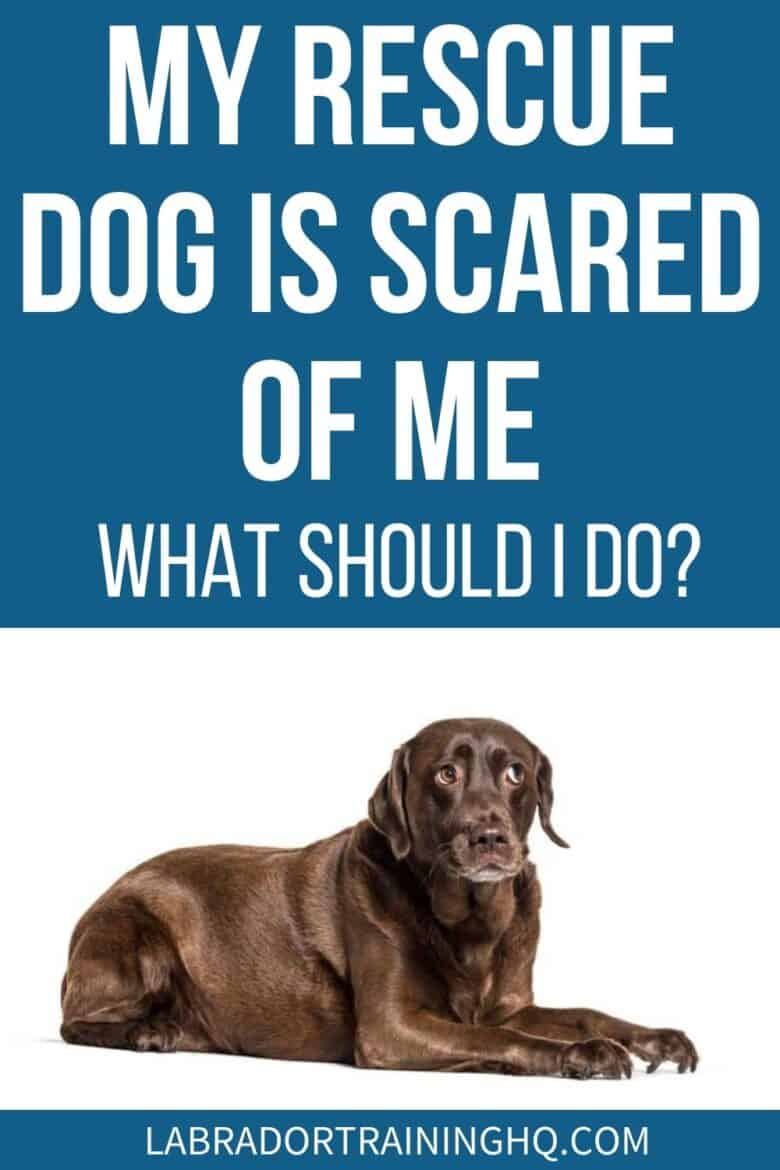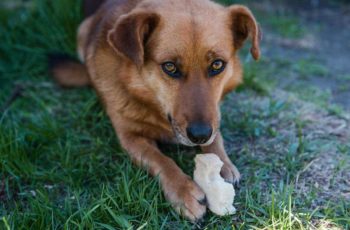This post may contain affiliate links. We may earn money or products from the companies mentioned in this post.
While you may have fallen in love with your rescue dog, at first sight, they might not feel the same.
Bad experiences can leave some dogs scared of humans, so it shouldn’t be overly surprising if your rescue dog is scared of you when you first take them home.
This doesn’t mean that you will never be able to bond with your dog or that it will always have a timid nature. With the right love and care, they can become the playful and carefree pup that they probably once were. You just need to be patient and committed to the process.
Read on as we look at signs that your rescue dog might be suffering from fear and anxiety, and as we share top tips on getting your rescue dog to acclimate to you and your home as soon as possible. Our aim is to have the two of you enjoying one another’s company as soon as possible.

Be warned; while there are things you can do to help your frightened dog, there are no quick fixes. It will always take time for them to feel comfortable with you and your family, but in time you can win the love and loyalty that they have to offer.
Contents & Quick Navigation
How Do You Identify A Fearful Rescue Dog?
It is not always obvious whether your dog has a fear of humans or not, as this kind of fear can manifest in ways that don’t necessarily make sense if you aren’t familiar with canine psychology.
Also, it is not only dogs that have been abused or otherwise had a bad experience with people that can be fearful in a new home. Imagine waking up one day and not having all the people and things that were familiar and you loved.
The dog may then have been in close quarters with many unfamiliar dogs and seeing different people every day in a shelter. They are then thrust into a new home where everyone is looking at them expectantly. It is enough to make any dog a little fearful.
How do you know if you have a dog that is seriously scared of humans on your hands, or just a dog that needs time to adjust?
1. Obvious Avoidance
Principally, dogs that don’t trust humans will try to avoid being around them. They will withdraw from you and might sit in the corner with their back to the wall so that they can keep an eye on what is happening around them.
You may also be able to pick up on whether a rescue dog is afraid of humans when you go to meet them. While it is natural for them to be nervous upon first meeting you, if they don’t warm up to you at all over the course of a visit, this could be a sign that they are seriously scared.
2. More Subtle Signs
Other signs that your dog may be stressed around humans can be more subtle. If they are toughing it out and getting close to you, frequent licking of their lips and yawning are actually signs that a dog is feeling highly stressed.
If they regularly show the whites of their eyes or tend to sit with their head lower than their back, these are other common signs of fear.
Frantic tail chasing, excessive barking, housetraining accidents, and pacing are also behaviors that a dog might display if they are feeling stressed out and fearful.
3. Steps To Take Before The Adoption
If you aren’t an experienced dog owner and don’t feel like you have the skills to support a frightened rescue dog, you might want to consider waiting for a more suitable adoption opportunity.
Read our guide to the best dog breeds to adopt from rescues and shelters.
Not sure how old your rescue dog is? Check out our guide to determining the age of your rescue dog.
How To Help A Timid Dog Adjust To A New Home
Bonding with your rescue dog and teaching them not to be afraid of you is going to take time. They need to see continuously that they can trust you and that you care for them so that they can start opening up. There is no magic fix, but there are things that you can do to make the process easier.
1. Give Them Space
It is only natural that when you bring your rescue dog home, everyone in the family is going to want to be close to them and spend time with them. Getting too much attention too quickly, though, can be stressful and intimidating.
Don’t force your rescue dog to spend time with you or sleep in your bed when you first bring them home. Stay in the vicinity of where they are so that they can get accustomed to your presence and your smell, but let them come to you when they are ready.
2. Introduce Them To The Home Gradually
When you bring a rescue dog home, your instincts might be to show them that your home is their home and give them free rein in the house. While this is a nice sentiment, it means that they have to take in a lot of new experiences, sights, and smells at once, and it can be overwhelming for them.
When you bring them home, it is better to restrict them to one area of the house and let them get to know this space first. As they start to feel comfortable in the first space, you can slowly open up new spaces around the home until, eventually, they do have free reign to roam.
Never force them into a new space when you open it up. Leave the door or access open, and let them decide when they are ready to poke their nose around the corner.
3. Create A Safe Spot
While you don’t want your new rescue dog to feel like they have to hide from you, you should give them a space they feel like they can retreat to when they need to take a break. This can actually make them feel more confident around the house, as they know they have somewhere to go if they need it.
Place a special dog bed in a quiet corner of the house and make sure to place things that smell like them in the space so that they know it is theirs.
4. Watch How You Speak
When you are interacting with your scared rescue dog, you will want to be in fairly good control of the way that you speak. You shouldn’t really yell at your dog at any time, but especially not while they are getting used to your home. Also try and avoid screaming in surprise or pleasure, as this could alarm your dog.
Try to speak in a calm and soothing voice. Remember, dogs understand better the tone of what you are saying than your words.
Consider the same tactics when stroking them. Treat them gently; they aren’t ready for rugged tummy rubs and rough play just yet. Also, avoid areas of the body that dogs can find sensitive, like their belly. One day they might enjoy a good belly rub, but only from someone that they trust.
5. Gradually Build Up Closeness
If your rescue dog has a fear of humans, they might not want to get too close to you physically. You need to respect their boundaries, and not only to avoid them giving you a nip out of fear or frustration. Pushing them outside of their comfort zone too soon can actually set them back rather than push them forward.
Avoid hovering over them, touching them in sensitive areas, or trying to give them hugs at this stage. If you want to give them a treat or a toy, rather than getting close to them, drop the toy or treat a few feet away from them and move away.
Let them approach and take it if they want it. Over time, you can start staying closer to the item, until you stand right by it and they are still happy to pick it up.
When you reach this stage, you can start giving them a light pet to see how they respond. Stick to the top of the head and back and be gentle.
6. Create A Schedule
While they are highly spontaneous beings by nature, dogs and children thrive on consistency. Knowing what is coming and what to expect lets them feel more comfortable to play and express themselves between appointments.
Get your dog on a regular schedule in terms of feeding, bathroom breaks, exercise, and sleep. Surprisingly, this can help them feel less scared and flummoxed when the unexpected happens.
Also, consider consistency within this schedule. They should sleep in the same place, and when you take them out for a walk, take them on the same route so that they have a chance to familiarize themselves with it.
Most importantly, continue feeding them the same food that they were eating at the shelter. After the first week or so you can gradually start moving them to your preferred food by mixing a little bit of the new food in with the old food and gradually increase the ratio.
This is important since, although dogs often seem like they will eat anything, they can be very picky eaters. The consistency in their diet is reassuring. This can also help avoid stomach upsets, which are not only messy to clean up, but can give your dog’s confidence in the house a blow.
7. Use Positive Reinforcement Training
You will need to start showing your new dog what exactly is expected of them in your new home pretty quickly. This means training, but the worst thing you can do with a dog that is already fearful of you is yell at them or punish them in an attempt to discourage unwanted behaviors.
Instead, you need to use positive reinforcement training with your dog to show them the right behaviors and build trust. Teaching your dog a completely new command is relatively easy. You simply say the command and show them what you want a number of times.
Every time you give the command and they respond in the desired way, you reward them with some type of treat (edible or other). Many dog breeds can pick up on a new skill like this in less than five repetitions.
Breaking bad behavior is harder. You need to ignore the behavior that you don’t want. This is important because if you give them attention, even negative attention, in response to this behavior, they may perceive it as a reward.
You then need to watch out for the tell-tale signs that they may be about to repeat this behavior. For example, dogs often sniff around before they pee somewhere, or start growling before they start on an epic barking session.
In these moments, teach them what you would like them to do instead. Take them to the door and then open it for them to go out and pee. If they look like they are about to start barking, use the sit or silent commands to get the behavior that you want.
Bear in mind that when rewarding them for their behavior, you might not want to give them hand-delivered treats at first. They might still not be comfortable getting too close to you, but they might get closer than they usually would for that treat. Rather than speeding up the process, this pushes them outside of their comfort zone and can slow down their progress.
FAQs
How long does it take for a rescue dog to trust you?
Each dog is different, so there is no hard and fast rule for how long it might take a dog to trust you; however, many canine behaviorists suggest a 3-3-3 rule for seeing how well your dog is doing compared to “average.”
This suggests that it is reasonable for your dog to be very fearful for the first three days. Within three weeks, they should be looking more comfortable, but they may still have significant anxiety. Within three months, they should be feeling comfortable in your home.
Why is my rescue dog so fearful?
It is not uncommon for rescue dogs to be very fearful when you bring them home. Even if they have come from a very loving environment, everything in their lives has changed and that can be scary. It is also possible, though, that your rescue dog has been abused in some way and they have developed a fear of humans.
Their previous owner may have abused them physically or shouted at them aggressively. They may have learned not to trust humans in general.
Can dogs remember being abused?
Dogs do not have the same kind of “episodic” memories as humans, so they will probably not remember specific experiences of abuse; however, they will learn to associate abusive behavior with certain things. For example, they may associate receiving pain with certain individuals, places, or circumstances.
This is why dogs can develop a fear of a specific abuser, but they may also extend this association to people in general. To break this, you need to give them new positive associations with being around humans.
The Verdict
When you bring a dog home from a rescue to be part of your family you want to start bonding with them straight away, but depending on their experiences and their temperament, a rescue dog may have developed a fear of humans.
This can mean that arriving in your home surrounded by a new family that wants to love them can actually be highly traumatic for them.
If your rescue dog seems like they are afraid of humans, there are things that you can do to make them feel comfortable and give them the security that they need to start bonding with you and thinking of your home as their home.
The most important thing to remember when dealing with a fearful dog is that you need to be patient. Just like humans, they can’t recover from trauma overnight but if you commit to the process of supporting them, in time you’ll have the loving and loyal canine companion that you want.
Do you have experience dealing with a fearful or timid rescue dog?
What’s your advice for supporting them?
Share your experience with the community in the comments section below.
Save To Pinterest

Top Picks For Our Dogs
- BEST PUPPY TOY
We Like: Snuggle Puppy w/ Heart Beat & Heat Pack – Perfect for new puppies. We get all of our Service Dog pups a Snuggle Puppy. - BEST CHEW TOY
We Like: KONG Extreme – Great toy for heavy chewers like our Labrador Retrievers. - BEST DOG TREATS
We Like: Wellness Soft Puppy Bites – One of our favorite treats for training our service dog puppies. - BEST FRESH DOG FOOD
We Like: The Farmer’s Dog – A couple months ago we started feeding Raven fresh dog food and she loves it! Get 50% off your first order of The Farmer’s Dog.
For a list of all the supplies we get for our new service dog puppies check out our New Puppy Checklist on the PuppyInTraining.com blog.
My Rescue Dog Is Scared Of Me, What Should I Do? was last modified: January 28th, 2022 by


